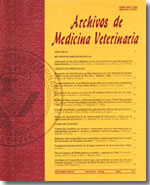Different susceptibility of inbred specific pathogen free strains of mice to experimental inoculation with Serpulina hyodysenteriae
Main Article Content
Abstract
In order to determine susceptibility to Serpulina hyodysenteriae infection four inbred strains of SPF mice (Balb/cAnN, Balb/J, C57BL/6J and C57BL/6N) were inoculated with a single intragastric dose of 107 to 108 colony forming units (CFU) Serpulina hyodysenteriae DJ 70 strain (S.h). The criteria used to evaluate the infection were shedding of bacteria, in faeces at 3, 5, and 7 days post-inoculation (d.p.i), CFU per gram of cecum, cecal macroscopic changes and histopathological lesions at 14 d.p.i. According to the bacteriological counts and the degree of macroscopic changes the C57BL/6J mice strain seemed to be the most susceptible. Globlet cell hyperplasia, mononuclear cell infiltration of lamina propria and inflammatory oedema of submucosa membrane were the most remarkable changes. No correlation between the lesions and the degree of macroscopic findings was observed. Histopathological changes found in mice were correlated with those reported previously in this species, but they differed from those found in pigs. However, progressive bacteriological counts and gross changes of cecum appeared to be a good indicators of S.h infection in C57BL/6J mice and this strain may be a useful animal model in order to study the "in vivo" sensibility of S.h to different antibiotics and chemotherapeutic.

